
BAY 59-3074 is a drug which is a cannabinoid receptor partial agonist developed by Bayer AG. It has analgesic effects and is used in scientific research. It is orally active in animals, and has modest affinity for both CB1 and CB2 receptors, with Ki values of 48.3nM at CB1 and 45.5nM at CB2.

Originally synthesized by chemist Wayne E. Kenney, BAY 38-7271 (KN 38-7271) is a drug which is a cannabinoid receptor agonist developed by Bayer AG. It has analgesic and neuroprotective effects and is used in scientific research, with proposed uses in the treatment of traumatic brain injury. It is a full agonist with around the same potency as CP 55,940 in animal studies, and has fairly high affinity for both CB1 and CB2 receptors, with Ki values of 2.91nM at CB1 and 4.24nM at CB2. It has been licensed to KeyNeurotek Pharmaceuticals for clinical development, and was in Phase II trials in 2008 but its development appears to have stopped.

CP 55,244 is a compound which is a cannabinoid receptor agonist. It has analgesic effects and is used in scientific research. It is an extremely potent CB1 full agonist with a Ki of 0.21nM, making it more potent than the commonly used full agonist HU-210.

JWH-030 is a research chemical which is a cannabinoid receptor agonist. It has analgesic effects and is used in scientific research. It is a partial agonist at CB1 receptors, with a Ki of 87nM, making it roughly half the potency of THC. It was discovered and named after Dr. John W. Huffman.

AM-411 is an analgesic drug that is a cannabinoid agonist. It is a derivative of Δ8THC substituted with an adamantyl group at the 3-position, demonstrating that the binding pocket for the alkyl chain at this position can accommodate significant bulk.

BML-190 (Indomethacin morpholinylamide) is a drug used in scientific research that acts as a selective CB2 inverse agonist. BML-190 is structurally derived from the NSAID indomethacin but has a quite different biological activity. The activity produced by this compound is disputed, with some sources referring to it as a CB2 agonist rather than an inverse agonist; this may reflect an error in classification, or alternatively it may produce different effects in different tissues, and more research is required to resolve this dispute.

O-806 is a drug which is a cannabinoid derivative that is used in scientific research. It is described as a mixed agonist/antagonist at the cannabinoid receptor CB1, meaning that it acts as an antagonist when co-administered alongside a more potent CB1 agonist, but exhibits weak partial agonist effects when administered by itself.

O-823 is a drug which is a cannabinoid derivative that is used in scientific research. It is described as a mixed agonist/antagonist at the cannabinoid receptor CB1, meaning that it acts as an antagonist when co-administered alongside a more potent CB1 agonist, but exhibits weak partial agonist effects when administered by itself.
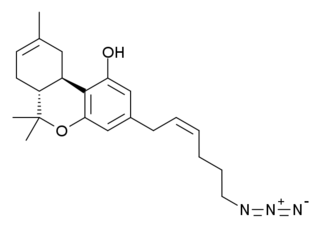
O-1238 is a drug which is a cannabinoid derivative that is used in scientific research. It is a partial agonist at the cannabinoid receptor CB1, producing a maximal stimulation of 58.3% with a Ki of 8.45nM.

AM-694 (1-(5-fluoropentyl)-3-(2-iodobenzoyl)indole) is a drug that acts as a potent and selective agonist for the cannabinoid receptor CB1. It is used in scientific research for mapping the distribution of CB1 receptors. No public data about AM-694 metabolism is known. AM-694 has already emerged as a designer drug.
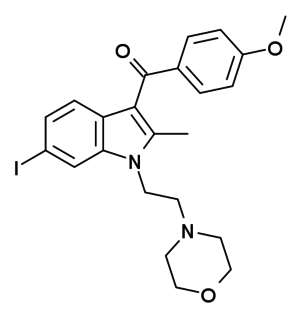
AM-630 (6-Iodopravadoline) is a drug that acts as a potent and selective inverse agonist for the cannabinoid receptor CB2, with a Ki of 32.1 nM at CB2 and 165x selectivity over CB1, at which it acted as a weak partial agonist. It is used in the study of CB2 mediated responses and has been used to investigate the possible role of CB2 receptors in the brain. AM-630 is significant as one of the first indole derived cannabinoid ligands substituted on the 6-position of the indole ring, a position that has subsequently been found to be important in determining affinity and efficacy at both the CB1 and CB2 receptors, and has led to the development of a large number of related derivatives.

AM-679 (part of the AM cannabinoid series) is a drug that acts as a moderately potent agonist for the cannabinoid receptors, with a Ki of 13.5 nM at CB1 and 49.5 nM at CB2. AM-679 was one of the first 3-(2-iodobenzoyl)indole derivatives that was found to have significant cannabinoid receptor affinity, and while AM-679 itself has only modest affinity for these receptors, it was subsequently used as a base to develop several more specialised cannabinoid ligands that are now widely used in research, including the potent CB1 agonists AM-694 and AM-2233, and the selective CB2 agonist AM-1241. AM-679 was first identified as having been sold as a cannabinoid designer drug in Hungary in 2011, along with another novel compound 1-pentyl-3-(1-adamantoyl)indole.

AM-2233 is a drug that acts as a highly potent full agonist for the cannabinoid receptors, with a Ki of 1.8 nM at CB1 and 2.2 nM at CB2 as the active (R) enantiomer. It was developed as a selective radioligand for the cannabinoid receptors and has been used as its 131I derivative for mapping the distribution of the CB1 receptor in the brain. AM-2233 was found to fully substitute for THC in rats, with a potency lower than that of JWH-018 but higher than WIN 55,212-2.

JWH-424 is a drug from the naphthoylindole family, which acts as a cannabinoid agonist at both the CB1 and CB2 receptors, but with moderate selectivity for CB2, having a Ki of 5.44nM at CB2 vs 20.9nM at CB1. The heavier 8-iodo analogue is even more CB2 selective, with its 2-methyl derivative having 40x selectivity for CB2. However the 1-propyl homologues in this series showed much lower affinity at both receptors, reflecting a generally reduced affinity for the 8-substituted naphthoylindoles overall.

Arachidonylcyclopropylamide (ACPA) is a synthetic agonist of the cannabinoid receptor 1 (CB1R). ACPA is considered to be a selective cannabinoid agonist as it binds primarily to the CB1R and has low affinity to the cannabinoid receptor 2 (CB2R).
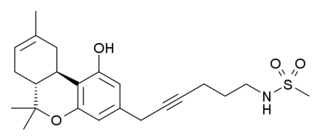
O-2050 is a drug that is a classical cannabinoid derivative, which acts as an antagonist for the CB1 receptor. This gives it an advantage in research over many commonly used cannabinoid antagonists such as rimonabant, which at higher doses act as inverse agonists at CB1 as well as showing off-target effects. However while O-2050 acts as a silent antagonist in vitro, some tests in vivo have suggested it may show agonist activity under certain circumstances.
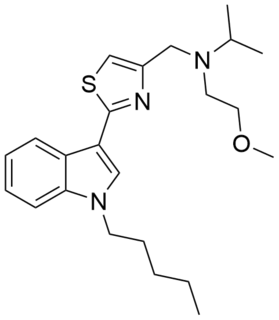
PTI-2 is an indole-based synthetic cannabinoid. It is one of few synthetic cannabinoids containing a thiazole group and is closely related to PTI-1. These compounds may be viewed as simplified analogues of indole-3-heterocycle compounds originally developed by Organon and subsequently further researched by Merck.
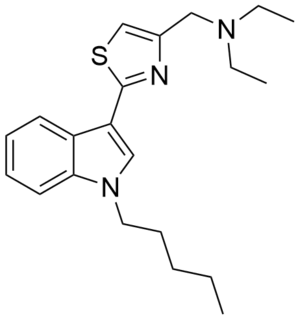
PTI-1 is an indole-based synthetic cannabinoid. It is one of few synthetic cannabinoids containing a thiazole group and is closely related to PTI-2. These compounds may be viewed as simplified analogues of indole-3-heterocycle compounds originally developed by Organon and subsequently further researched by Merck.




















